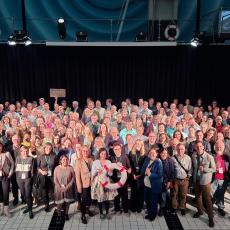Local politicians risk their power to create more colleagues
This column was edited and co-published by Zocalo Public Square. Photo credit: Official photo, Los Angeles County Board of Supervisors
Are people biting pit bulls? Are those pigs flying overhead? Has hell frozen over, despite the October heat wave?
Fair questions, all. Because politicians in the most populous local jurisdiction of America’s most populous state are actually seeking to reduce their own power.
Even in times as strange as our own, Measure G seems impossible.
Measure G is an amendment to the Los Angeles County charter on this November’s ballot. The measure proposes to add four new supervisorial seats to the county board and establish an elected county executive. Both additions would dilute the power of the existing five elected supervisors, who now serve as both legislators and executives of the 10-million-person county.
Which is why it’s so remarkable that three of those five supervisors drafted Measure G themselves and put it on the ballot. That this extraordinary act was taken by people elected in politically incestuous Los Angeles—it’s still Chinatown, Jake—is enough to make even a cynical columnist wonder if we are entering an era of actual, honest-to-goodness structural change.
To be sure, structural change in California is a cousin of Bigfoot or Warren Beatty—creatures about which there are many conversations but almost no verified sightings. But Measure G improbably brings to Southern California the idea of making our elected legislative bodies bigger, more representative, and closer to the people.
This is part of a larger trend. Nationally, we’re seeing proposals in Congress to expand the number of people on the Supreme Court. Academics and political figures, on left and right, have called for expanding the House of Representatives for the first time in more than a century. And in California, we’ve seen proposals, including failed ballot initiatives, to increase the size of our legislature, proportionally the country’s smallest such body, to 10,000 or more.
While those proposals are generally seen as politically unrealistic, Measure G has a real chance of winning.
A win for G would be the L.A. political equivalent of the Chicago Cubs’ 2016 World Series victory—the baseball team’s first title in more than a century. The L.A. County Charter, adopted in 1912 when there were only 500,000 people here and women couldn’t vote, established a five-member board of supervisors. Attempts to expand the board or create a county executive—going back to 1926—have all failed.
As a result, the country’s most populous country has long been run quietly, and behind the scenes, by a very small number of people. The five L.A. County supervisors appoint the county CEO and supervise the county’s departments, from public works to the registrar-recorder. L.A.’s most powerful people and institutions generally like how easy is to get what they want from the low-profile county government.
So why does change seem possible now?
One potential reason is the election of more progressive board members, notably former West Hollywood Mayor Lindsay Horvath, who has championed Measure G. Racial and ethnic groups have embraced the idea of greater representation on the board, especially for Latinos. Former Supervisor Zev Yaroslavsky, who often advises current supervisors (and—full disclosure—is on Zócalo’s advisory board), has pushed the idea. Feminists theorists might suggest that the fact that all five L.A. county supervisors are now women could make the board more open to power-sharing.
Events have fueled Measure G as well. It helped that, after the last census, the county’s redistricting commission recommended an increase in the number of seats (to at least 15) to make the body more representative of diverse L.A. Also, high-profile scandals at a different local government—the city of Los Angeles—have put a new focus on governance here.
But the greatest momentum for structural change comes from L.A.’s acute social problems of economy, mental health, and housing. Supervisors and other progressives have complained that the outdated county government structure gives too much power to county bureaucrats, who can stall and wait out proposals for change from term-limited supervisors. More elected representatives, and an elected executive, could galvanize the public and put more pressure on those bureaucrats to revamp county’s health and safety net programs for today’s needs.
L.A. County has more people than all but 10 U.S. states. So, it’s fitting that Measure G would make the county government more like a state government, and Los Angeles more like California. The elected county executive job would give Southern California its own version of the governorship. And Measure G would make the board of supervisors more like the state legislature, by establishing a public and transparent budgeting process, a non-partisan legislative analyst to assess difficult policy questions, and an ethics body to police official behavior.
Given the state-like ambition behind Measure G, one crucial detail seems too small. If G passes, the nine L.A. County supervisors will still represent more than one million people each—by far the largest local elected jurisdictions in America. By contrast, the three states with populations most similar to L.A.—Michigan, North Carolina, and New Jersey—each have at least 120 elected legislators.
Measure G supporters have said that adding even more supervisors would add to the costs of the board and risk backlash from voters who don’t want more politicians. Backers also say that interest groups were just more comfortable with nine supervisors—the most common number of supervisors in expansion proposals dating back to the 1970s, when the TV show “Eight Is Enough” was being filmed in North Hollywood.
Another weakness of Measure G is its slow, cautious rollout. New maps for a nine-member board wouldn’t take effect until 2032, by which time the current board members will be termed out.
Despite these caveats, a Measure G victory could be the big political earthquake this state has needed. L.A.’s example might inspire other counties and local governments to beef up their democratic capacity, too.
And perhaps local structure change might inspire structural change in the state government—dysfunctional, ineffectual, and stuck with a governing charter written in 1879. If hell stays frozen over, and L.A. politicians manage to reduce their own power, then who knows? California might finally get the new constitution it needs.




